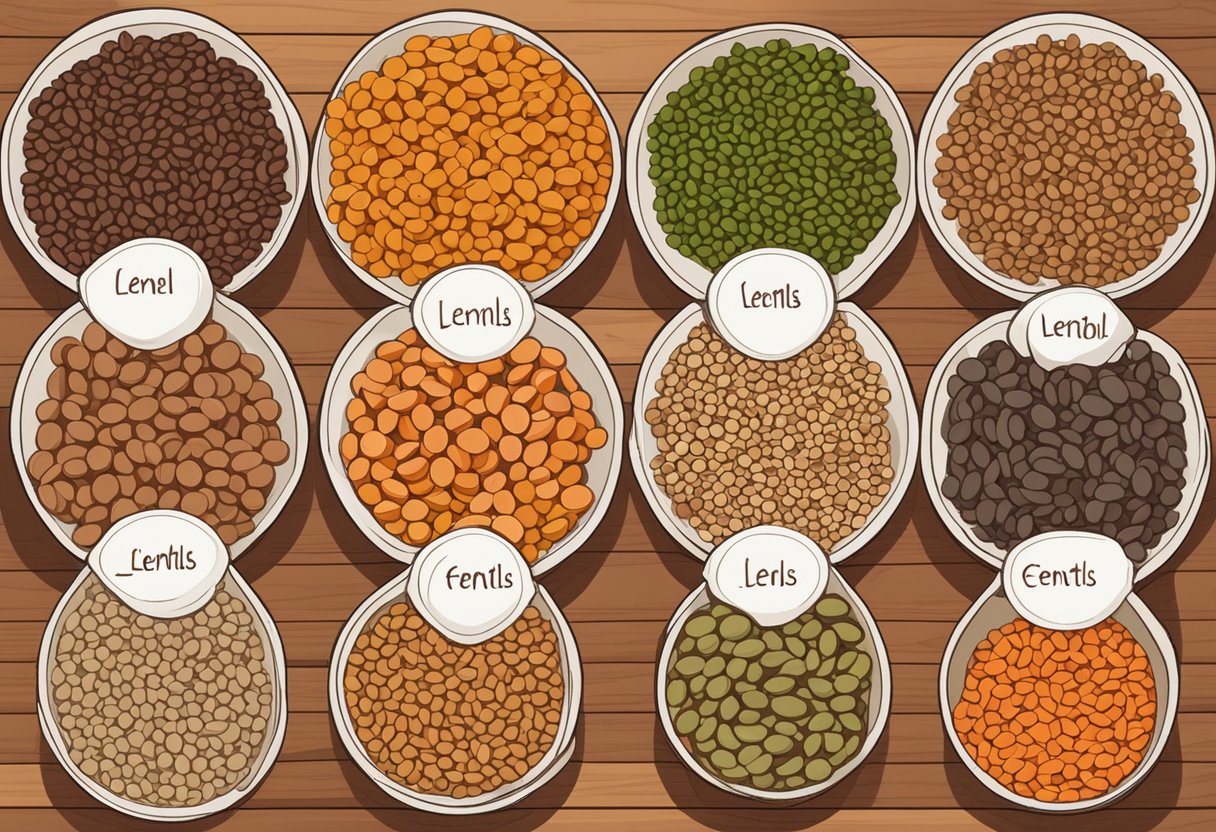Types Of Lentils
Lentils are a type of legume that are popular for their versatility and nutritional value. They come in a variety of colors and sizes, each with its own unique flavor and texture. Lentils are an excellent source of protein and fiber, making them a great addition to any healthy diet.

Common varieties of lentils include brown, green, red, and black. Brown lentils are the most widely available and are often used in soups and stews. Green lentils are slightly firmer and hold their shape well, making them a great choice for salads. Red lentils are softer and cook quickly, making them ideal for curries and purees. Black lentils are small and firm with a slightly nutty flavor, making them a great choice for salads and side dishes.
When it comes to culinary uses, lentils can be used in a variety of dishes, from soups and stews to salads and side dishes. They can also be used as a meat substitute in vegetarian and vegan dishes. Lentils are a great source of protein and fiber, making them a healthy addition to any diet.
Key Takeaways
- Lentils are a type of legume that come in a variety of colors and sizes, each with its own unique flavor and texture.
- Common varieties of lentils include brown, green, red, and black, each with its own culinary uses.
- Lentils are an excellent source of protein and fiber, making them a healthy addition to any diet.
Common Varieties of Lentils
Lentils are a versatile and nutritious legume that come in a variety of colors and sizes. Each type of lentil has its own unique flavor and texture, making them a great addition to a variety of dishes. Here are some of the most common varieties of lentils:
Brown Lentils
Brown lentils are the most common variety of lentil and are readily available at most grocery stores. They have a mild, earthy flavor and hold their shape well when cooked, making them a great choice for soups, stews, and salads. Brown lentils are also a good source of protein, fiber, and iron.
Green Lentils
Green lentils have a slightly peppery flavor and hold their shape well when cooked, making them a great choice for salads and side dishes. They are also a good source of protein, fiber, and iron.
Red Lentils
Red lentils have a sweet, nutty flavor and cook quickly, making them a great choice for soups and stews. They are also a good source of protein, fiber, and iron.
Black Lentils
Black lentils, also known as beluga lentils, have a rich, earthy flavor and hold their shape well when cooked. They are a great choice for salads and side dishes and are also a good source of protein, fiber, and iron.
French Green Lentils
French green lentils, also known as Puy lentils, have a nutty, earthy flavor and hold their shape well when cooked. They are a great choice for salads and side dishes and are also a good source of protein, fiber, and iron.
In addition to these common varieties, there are many other types of lentils available, each with their own unique flavor and texture. Whether you’re looking for a hearty soup or a light salad, there’s a lentil variety that’s perfect for your dish.
Culinary Uses
Lentils are versatile legumes that can be used in a variety of dishes. They are a great source of protein and fiber, making them a popular ingredient in vegetarian and vegan diets. Here are some culinary uses for different types of lentils.
Soups and Stews
Brown lentils are the most common type of lentils and are best used for soups and stews. They cook in 20 to 30 minutes and hold their shape well, making them perfect for hearty dishes. Green lentils are also good for soups and stews, as they retain their shape after cooking.
Salads and Sides
Green lentils are the best choice for salads and sides. They have a slightly nutty flavor and hold their shape well, making them a great addition to warm salads and casseroles. French lentils are also good for salads and sides, as they have a delicate flavor and hold their shape well.
Purees and Dips
Red lentils are the best choice for purees and dips. They cook quickly and become soft and creamy when cooked, making them perfect for hummus and other dips. Yellow lentils are also good for purees and dips, as they have a mild flavor and become creamy when cooked.
Meat Alternatives
Lentils are a great meat alternative and can be used in veggie burgers and other meatless dishes. Brown lentils are a good choice for veggie burgers, as they hold their shape well and have a meaty texture. Red lentils can also be used as a meat alternative, as they become soft and creamy when cooked.
Nutritional Profile
Lentils are a great source of nutrition and are widely consumed across the world. They are a rich source of macronutrients, vitamins, and minerals that are essential for maintaining good health.
Macronutrients
Lentils are a good source of carbohydrates, with a one-cup serving of cooked lentils providing around 40 grams of carbs. They are also high in protein, with a one-cup serving containing around 18 grams of protein. Lentils are low in fat, with less than 1 gram of fat per serving.
Vitamins and Minerals
Lentils are a rich source of several vitamins and minerals. They are high in iron, with a one-cup serving providing around 37% of the recommended daily intake. Lentils are also high in potassium, with a one-cup serving containing around 731 milligrams of potassium. They are also a good source of antioxidants, manganese, and folate.
Dietary Fiber and Protein Content
Lentils are an excellent source of dietary fiber, with a one-cup serving containing around 15.6 grams of fiber. This makes them an ideal food for maintaining digestive health and preventing constipation. Lentils are also high in protein, which makes them a good food for building and repairing muscles.
In summary, lentils are a great source of nutrition, with a good balance of macronutrients, vitamins, and minerals. They are particularly high in iron, potassium, and dietary fiber, making them an ideal food for maintaining good health.
Cooking Techniques
Soaking and Preparation
Before cooking any type of lentil, it is recommended to soak them in water for a few hours or overnight. Soaking helps to reduce the cooking time and improve the texture of the lentils. It also helps to remove any dirt or debris that may be present.
To prepare lentils for cooking, rinse them under cold water and remove any debris or stones. Lentils do not need to be soaked, but it is recommended for better texture and flavor.
Boiling and Simmering
The most common cooking method for lentils is boiling or simmering. To cook lentils, add them to a pot with enough water or broth to cover them by about an inch. Bring the liquid to a boil, then reduce the heat to a simmer. Cook the lentils until they are tender, which can take anywhere from 15 to 45 minutes depending on the type of lentil.
It is important to keep an eye on the lentils while they are cooking to make sure they do not become too mushy or overcooked. Adding salt or acidic ingredients like tomatoes or vinegar too early can also make the lentils tough, so it is best to add them towards the end of the cooking process.
Roasting and Browning
Roasting or browning lentils can add a nutty flavor and crispy texture to dishes. To roast lentils, preheat the oven to 375°F, spread the lentils on a baking sheet, and drizzle with oil. Roast for 20-25 minutes, stirring occasionally, until they are crispy and golden brown.
Browning lentils can also be done on the stovetop. Heat a skillet over medium-high heat and add the lentils. Cook, stirring occasionally, until they are crispy and browned on the outside. This method is best for firmer lentils like French or Beluga lentils.
Overall, lentils are a versatile and nutritious ingredient that can be cooked in a variety of ways. With the right cooking techniques, lentils can be transformed into delicious soups, stews, salads, and more.
Cultural and Regional Varieties
Lentils are a staple food in many cultures around the world. They are used in a variety of dishes, ranging from soups and stews to salads and side dishes. Here are some of the cultural and regional varieties of lentils that are commonly used in cooking.
Lentils in Indian Cuisine
Lentils, also known as dal, are a staple food in Indian cuisine. There are many different varieties of lentils used in Indian cooking, including urad dal, chana dal, and moong dal. Lentils are often used in soups, stews, and curries, and are also used to make dosas and idlis.
North American Lentil Cultivation
Canada is one of the largest producers of lentils in the world, and is known for its high-quality lentils. The most commonly cultivated lentil varieties in North America are the green lentil and the red lentil. Lentils are used in a variety of North American dishes, including soups, stews, and salads.
Mediterranean and Middle Eastern Dishes
Lentils are also commonly used in Mediterranean and Middle Eastern dishes. Beluga lentils, also known as lentilles du Puy, are a popular variety of lentils used in French cuisine. Chickpeas are another legume that is commonly used in Mediterranean and Middle Eastern dishes. Horse gram, a type of lentil that is popular in South Asia, is also used in some Mediterranean and Middle Eastern dishes.
Overall, lentils are a versatile and nutritious ingredient that can be used in a variety of dishes from around the world. Whether you are making a soup, a stew, or a salad, there is a variety of lentil that is perfect for your dish.






